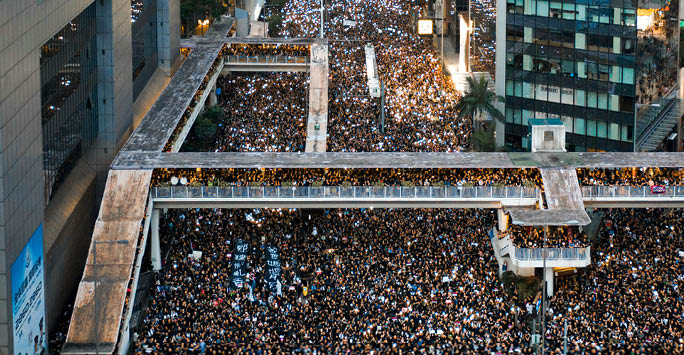
In 2019 a series of protest-related suicides took place for the first time in Hong Kong's history. The Anti-Extradition Bill (AEB) campaign began in March and in a matter of months escalated into a pro-democratic movement with millions of participants.
The movement shares some common features of the mass movements across the world in recent years, such as for example the US Occupy Wall Street movement in 2011 and the Spanish Indignados Movement 2011-12. AEB was led by young people and had a ‘leaderless’ character, being heavily reliant on horizontal organisation via social media apps and online forums.
At an early stage of the movement, a man stood on the scaffolding outside a mall in Admiralty, where large-scale demonstrations were usually held. He wore a yellow raincoat – yellow is used to represent pro-democracy sentiment – and put up a large banner stating the protest demands. His fall from height was broadcasted live on news channels and social media by witnesses.
Six more suicides have since taken place that were reported as linked to protests. They were widely publicised and mourned. All were under the age of 35.
Counselling services received an increase in cases since the first fall. Some netizens from the yellow camp revealed their suicide plans online that in turn triggered high-profile searches from community members.
Worried that copycat suicides may occur, mental health professionals followed the World Health Organization guidelines and warned media and the public not to publish sensational reporting or posts to glorify the suicides, or call the people who took their lives ‘martyrs’.
How do we make sense of suicides in this context? While mental health reasons are often used to explain suicide (e.g. depression), for suicides as a political act, individualistic and psychocentric explanations fall short of an explanation. We need to consider how people think about suicides. A qualitative exploration will help us achieve this.
Exploring the social meaning of suicide may help us better understand the spread of suicide that mental health professionals worry about. As Miklin et al. (2019) suggested, exposure to suicide does not inherently increase suicide risk.
Crucially, suicide risk increases contingent on different factors, including how witnesses interpret the meaning of these suicides and the context surrounding the death.
In Hong Kong's case, do young protestors consider the people taking their lives in these incidents ‘martyrs’? Do they see suicide as an understandable, acceptable and even noble act? Do protest-related suicides become an acceptable means in making political claims in collective action? Do they think these deaths are preventable and what could be done?
Studying the Social Context of Suicides in Hong Kong
To answer these questions, I invited 35 young people of mixed gender, aged between 19-35, and self-identified as belonging to the ‘yellow’ camp for in-depth interviews. My research team asked about their perceptions of suicides before and after the protest-related suicides, as well as their reactions after knowing about these incidents.
Preliminary analysis shows that before the protest-related suicides took place, they saw suicides as an understandable act: that people may take their lives when lives become unbearable, or when they think there are no solutions for problems they are facing.
Most participants did not see suicide as directly linked to a mental disorder. They attributed reasons for suicide to social causes, for example, identifying the turbulent political climate in Hong Kong in the years before the AEB movement.
The protest-related suicides did not alter their views on suicides in general. Yet, they interpreted these incidents in two different ways. The first group felt ‘sad’ and saw them as a suicide more than a political action, i.e. these suicides are due to individuals’ decisions with different personal reasons. The second group saw them as a political action making a political demand. Participants in this group used words like ‘shocked’, ‘respect’ and ‘admiration’ when reflecting their reactions to protestors’ suicides. They also attributed the root cause of these suicides to political oppression, feeling angry towards the government for contributing to such.
Although last notes with political messages were found in the cases of protest suicides, not all of these incidents were seen by participants as a political action. Some considered that only those that had an observable mobilising effect can be counted as a form of protest.
The yellow raincoat the first person wore became one of the symbols of the movement. While some participants became more involved in the movement as they saw the first suicide as the first ‘sacrifice’, most participants did not endorse the taking of one’s own life as the way to make a political claim.
How did they react after hearing about the suicides? Social media apps played a key role here. They expressed their grief and anger towards the government with their friends or fellow protestors.
When there were an increasing number of messages reporting on missing protestors being circulated on social media, some participants told us they helped search for these people, who they didn’t personally know. Some with counselling backgrounds helped establish ad hoc platforms in social media apps to offer support anonymously to help prevent further suicides.
The solidarity among protestors may lead them to look out for each other, creating a safety net in the community. In times of political crisis, when protestors may not feel safe to seek help from traditional mental health professionals (who may come from the opposite political position or reveal activist participation). Social media apps allow anonymity and facilitate community organising for suicide prevention. Empowering the public to take care of each other in these platforms – e.g. by circulating messages on how to talk to people with suicidal ideations – may help nurture such safety net in times of political crisis.
While the high-profile incidents may become part of the collective memory in Hong Kong, the findings seem to suggest that suicide becomes an understandable, but not socially endorsed, form of political action.
(Acknowledgement: This research is funded by Hong Kong Research Grants Council.)
About the author

Dr Lynn Tang is a lecturer in the Department of Sociology, Social Policy and Criminology at the University of Liverpool. She is interested in using qualitative methods in understanding how inequalities and social injustice impact on mental wellbeing and how these shape the journey recovering from distress and mental ill-health. She has researched on the recovery journeys of Chinese mental health service users in the UK and suicide prevention in Hong Kong. Her current project is on suicide, collective trauma and political crisis in Hong Kong.
References
Miklin, S., Mueller, A., Abrutyn, S., & Ordonez, K. (2019). What does it mean to be exposed to suicide?: Suicide exposure, suicide risk, and the importance of meaning-making, Social Science & Medicine, 233, 21-27. https://doi.org/10.1016/j.socscimed.2019.05.019